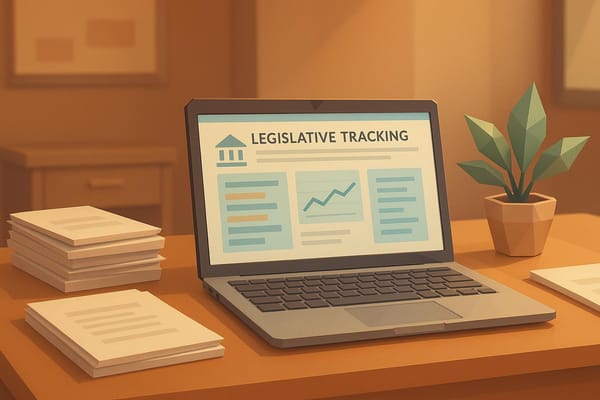How Advocacy Coalitions Influence Legislation
Explore how advocacy coalitions shape legislation through shared goals, strategic resource management, and digital tools for effective influence.

Advocacy coalitions are groups that bring together people and organizations with shared goals to influence laws and policies. They simplify complex issues for the public, connect citizens with lawmakers, and use resources like financial support, expertise, and technology to push for change.
Key points:
- What they do: Advocacy coalitions work to shape laws by uniting stakeholders with shared values and objectives.
- How they succeed: They rely on strong member roles (like policy experts and grassroots organizers), effective resource management, and clear communication.
- Tools they use: Digital platforms like Cicada.guide help track legislation, simplify legal language, and improve outreach.
- Examples: Successful coalitions have influenced climate policies, healthcare reforms, and corporate diversity laws.
Core Elements of Effective Coalitions
Shared Values and Objectives
Strong coalitions bring together diverse members by clearly outlining shared values and specific legislative goals. This clarity helps attract dedicated participants and ensures the group stays focused, working together to influence legislation. Diversity among members also strengthens the coalition by bringing a mix of skills and perspectives.
Member Composition
A coalition's power comes from its members, each contributing unique skills and resources. Here's a breakdown of key member roles:
| Member Type | Role | Impact |
|---|---|---|
| Policy Experts | Provide technical analysis and draft legislation | Ensure proposals are legally sound and practical |
| Grassroots Organizers | Mobilize community support and local action | Build public pressure and show broad constituent backing |
| Subject Matter Specialists | Offer in-depth expertise | Boost credibility and add technical depth to proposals |
| Communications Professionals | Develop messaging and media strategies | Spread the coalition's message and raise public awareness |
| Legal Experts | Navigate legislative processes | Ensure compliance and find strategic opportunities |
Resource Management
Alongside shared goals and diverse membership, smart resource management is key to a coalition's success. Effective coalitions focus on gathering and using resources efficiently:
-
Financial Resources
Leaders create transparent systems for managing funds, including clear budgets, diverse funding sources, and regular financial updates. -
Information Resources
Coalitions use tools to monitor legislative changes, analyze impacts, and share updates. For example, platforms like cicada.guide provide AI-driven summaries of complex legislation, helping members stay informed. -
Human Capital
Members' skills are matched to specific tasks, with opportunities for training, engagement, and leadership development to keep the group dynamic and effective.
Methods of Legislative Influence
Public Opinion Campaigns
Advocacy groups often rally support by running campaigns that inform and engage the public. These campaigns combine traditional outreach methods with modern digital tools to reach more people. By using technology, they break down complicated legislation into simple, easy-to-understand messages. Key strategies include:
- Simplifying legislative details for better public understanding
- Using social media to expand their reach
This public engagement helps set the stage for effective communication with lawmakers.
Legislator Outreach
Once public support is established, advocacy groups focus on directly engaging lawmakers. This involves clear and concise communication. Successful groups build ongoing relationships with legislators through face-to-face meetings and written correspondence, providing actionable information that reflects the concerns of their constituents.
Data-Driven Advocacy
Digital tools play a crucial role in advocacy efforts. These tools allow groups to track voting records, stay updated on legislative changes, and measure the success of their campaigns. Platforms like cicada.guide provide real-time legislative data, enabling advocacy groups to adjust their strategies effectively.
Building Coalitions for State Legislative Reforms
Examples of Successful Coalitions
Here are some real-world examples showing how organized advocacy can lead to meaningful change.
Climate Policy Changes
Advocacy groups have successfully influenced environmental policies by combining grassroots efforts with data-based approaches. In various states, coalitions have pushed for measures to protect communities near environmental hazards. They use digital tools to simplify complex legislation for citizens and track legislative actions - similar to resources like cicada.guide.
State Healthcare Reform
Focused advocacy has played a key role in driving state-level healthcare reforms. For example, coalitions have addressed gaps in mental health services by collecting data, organizing community events, and leveraging digital communication to engage state legislators. These platforms allow citizens to stay informed about legislative progress and actively participate in shaping policies.
Corporate Board Diversity Laws
Advocacy groups, shareholders, and lawmakers have worked together to promote corporate governance changes. By presenting clear data on board diversity and engaging policymakers, these coalitions have supported initiatives aimed at increasing diversity in corporate leadership. Digital tools have made outreach and coordination more efficient.
These examples illustrate how combining grassroots efforts, data analysis, and digital tools can drive legislative change and empower citizens to take part in the democratic process.
Problems and Solutions
Common Obstacles
Limited resources and inconsistent messaging among different stakeholders often slow down legislative efforts. Tight budgets can hinder research, while coordinating across various groups makes it harder to respond effectively to legislative changes.
Digital Tools for Advocacy
Digital tools address these challenges by improving collaboration and access to information. Platforms like Cicada.guide offer solutions that help coalitions stay on top of legislation and advocate more effectively. For instance, Cicada.guide's AI-powered summaries simplify complex bills, while real-time tracking feeds keep all stakeholders updated. Its communication tools also make it easier to connect with legislators, providing data-driven insights and voting records to support advocacy efforts. In March 2024, environmental advocacy groups in California saw a 20% boost in member engagement after using these tools to track a renewable energy standards bill.
Here’s how digital platforms help coalitions:
| Feature | How It Helps |
|---|---|
| AI-powered Summaries | Breaks down complex legislation quickly |
| Real-time Updates | Allows fast responses to changes |
| Representative Tracking | Improves outreach to legislators |
| Automated Feeds | Simplifies information sharing |
These tools make it easier for coalitions, especially those with small teams, to overcome resource and coordination challenges.
Conclusion
Success Factors
Strong citizen involvement and clear communication are key to effective advocacy coalitions. When legislative information is easy to access, communities are better equipped to influence policy decisions. A focused message paired with consistent outreach ensures that citizen voices are heard during legislative discussions. Digital tools add to these efforts by amplifying the coalition's reach and efficiency.
Technology's Impact
Modern tools are reshaping how coalitions operate by simplifying the often-complicated legislative process. Platforms like cicada.guide make it easier to track legislation and improve communication. By combining traditional community engagement methods with these digital tools, coalitions can adapt quickly to legislative changes and make a greater impact on policy outcomes.




